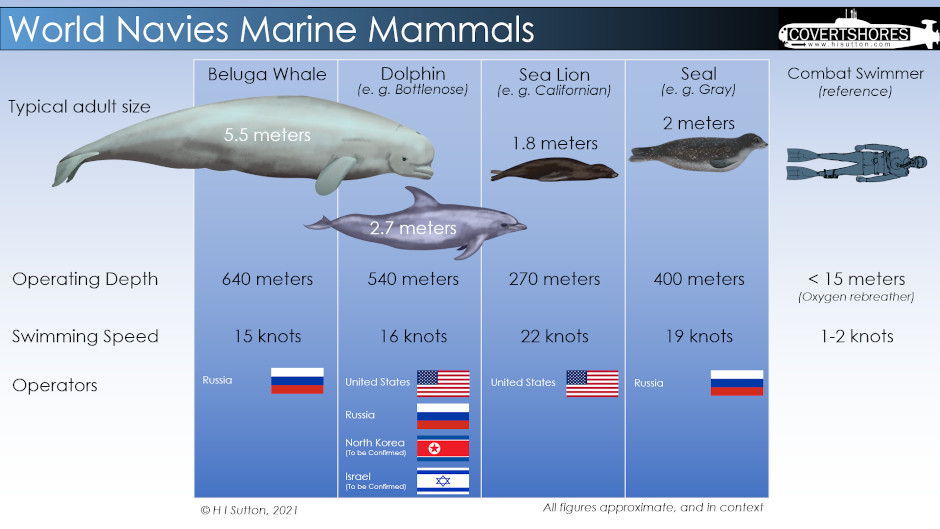Killer Dolphins: World Survey Of Navy Marine Mammal Programs



 There have been recent revelations that Israel may have trained dolphins in counter-diver operations. This brings Navy marine mammal programs back into the spotlight. While many are quick to find humor in this topic (sharks with frickin' laser beams anyone?), it is of course a serious naval capability. Based on public disclosure and OSINT (Open Source intelligence), I have identified four countries with current marine mammal programs. The United States, Russia, North Korea, and Israel. Sweden has also trained seals in the past but does not have a current program.
There have been recent revelations that Israel may have trained dolphins in counter-diver operations. This brings Navy marine mammal programs back into the spotlight. While many are quick to find humor in this topic (sharks with frickin' laser beams anyone?), it is of course a serious naval capability. Based on public disclosure and OSINT (Open Source intelligence), I have identified four countries with current marine mammal programs. The United States, Russia, North Korea, and Israel. Sweden has also trained seals in the past but does not have a current program.
The main type of animal used are Dolphins. For example Bottlenose Dolphins. However Beluga Whales, Seals and Sealions are also known to be used.
These marine mammals are intelligent and can be trained to perform a range of tasks. While different species may have different attributes, the below roles generally apply to all:
Missions for Navy Marine Mammals
Anti-saboteur
The main task popularly imagined, this involves the animal finding enemy combat swimmers. Because they cannot differentiate friend from foe, they are likely to be trained and equipped to mark the diver. This would be done with a buoy which, generally would be attached to the swimmer's back to make it difficult to remove. A diver, however well trained, is no match for the marine mammal in this scenario.
The marine mammal may also be trained to interfere with small boats, of the type used to deliver divers. They are unlikely to be useful against swimmer delivery vehicles (SDVs) and may in fact shy away from them.
There is also the suggestion that marine mammals could be equipped with a weapon. This could be a spear-gun or hollow-spear which injects compressed gasses into the victim. These weapons would be attached to the animal's head or nose and trigged by impact. Because of the obvious friend-or-foe problem, this scenario is typically discounted. But it is plausible.
THE book on Special Forces subs Covert Shores 2nd Edition. A world history of naval Special Forces, their missions and their specialist vehicles. SEALs, SBS, COMSUBIN, Sh-13, Spetsnaz, Kampfschwimmers, Commando Hubert, 4RR and many more.
Check it out on Amazon
Mine Countermeasures
Another role which marine mammals are well known for is finding mines. Particularly bottom mines and moored mines. These would be inspected with a camera and/or marked with a buoy. Marine mammals may have advantages, both because of their inherent senses and because they are noiseless.
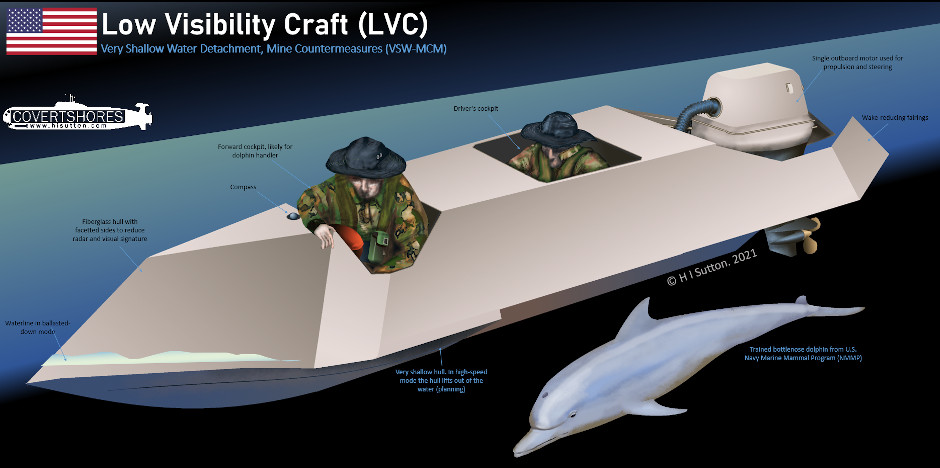
CLICK to enlarge. Original artwork.
Intelligence missions
It is likely that some marine mammals have been trained to perform intelligence gathering missions. Cameras or other sensors can be carried to areas of interest, such as inspecting undersea infrastructure. Capabilities would be similar to remote operated vehicles (ROVs), minus any manipulation. But with the advantage of being less likely to be detected. Marine mammals are the perfect stealthy platforms within their operational envelope. The limitation would be how to get them to and from the target.
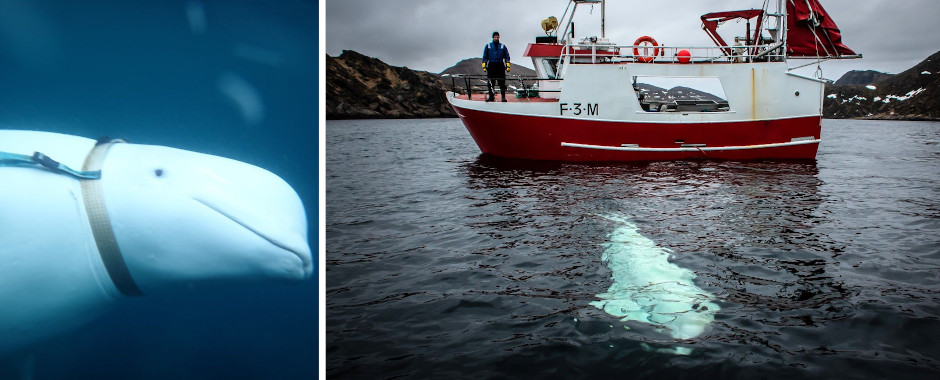
On April 23 2019 a trained Beluga whale appeared off the Norwegian coast. It was befriended by locals and named Hvaldimir. I believe tat it was trained by the Russian Navy. Its mission off the Norwegian coast is open to speculation. Photos by Marine biologist and inspector at the Directorate of Fisheries' Marine Service, Jørgen Ree Wiig.
Retrieving objects from the sea floor
Marine mammals have been trained to directly pick up small objects from the seabed, or attach buoys or hooks to larger ones. For example, retrieving missiles after trials. This may be cheaper than human divers. However with the advent of modern ROVs this role seems less differentiating.
Offensive actions
It is often suggested that marine mammals could be trained to attach limpet mines to enemy vessels. They could easily sneak into harbors undetected. However the friend=or-foe problem could create challenges. Therefore this is seen as the least likely of the above missions.
The units which train them are, generally, on the peripherals of the main navy structure. Their combat effectiveness and future role may be hard to assess. both inside the navy and externally. And, opportunistically, mammals trained for one role may be employed in another. This may make them less reliable.
Like any defense system, marine mammals have their strengths and limitations. Relative to a human they are swim faster, go deeper, are longer ranged, better sense their surroundings and (generally) are more stealthy. And they cannot talk if captured. On the flipper side (sorry!) they are less mission-aware, less flexible and unable to do cross-beach missions.
Additionally, although they have better endurance than humans, it is still limited. Therefore they require small boats for transport to and from many missions. For deployments they can be transported by ship or, with special care, in aircraft.
Get The essential guide to World Submarines
This Covert Shores Recognition Guide Covers over 80 classes of submarines including all types currently in service with World Navies.Check it out on Amazon
Operators
Russia
Russia has the most extensive, and diverse, marine mammal program. Although this has its roots in the Soviet Union, the projects appear to have been largely reestablished after years of decline. There are two distinct projects, one with Beluga whales and seals in the Arctic, and another with dolphins in the Black Sea.
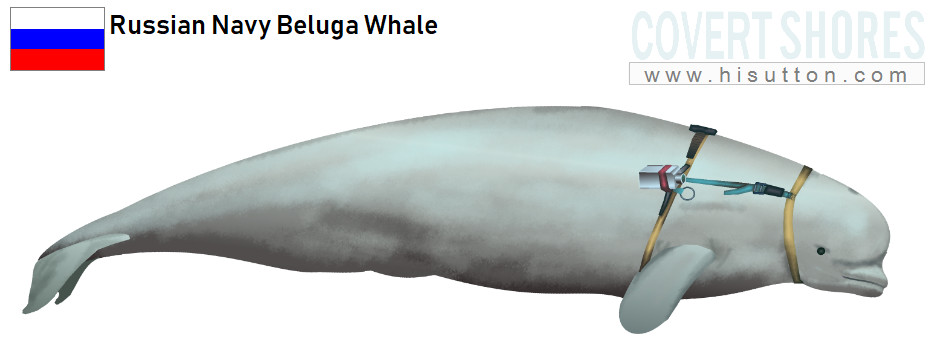
The arctic project is based near several of the Northern Fleet's submarine bases on the Kola Peninsular. The animals used are well suited to the cold arctic waters. The seals are known to be trained in base defense, working in teams to mark enemy divers. The role of the Belugas is less clear.
In April 2019, around the same time that the Beluga whale turned up in Norway, a pen was set up at the secret GUGI base of Olenya Guba. The pen matches those used for the Belugas and associates the program with GUGI (main directorate of deep sea research). This implies intelligence gathering missions as well as base defense.
The Black Sea Fleet operates dolphins, based near Sevastopol in Crimea. There is evidence that these have, on occasion, been deployed to Tartus in Syria.
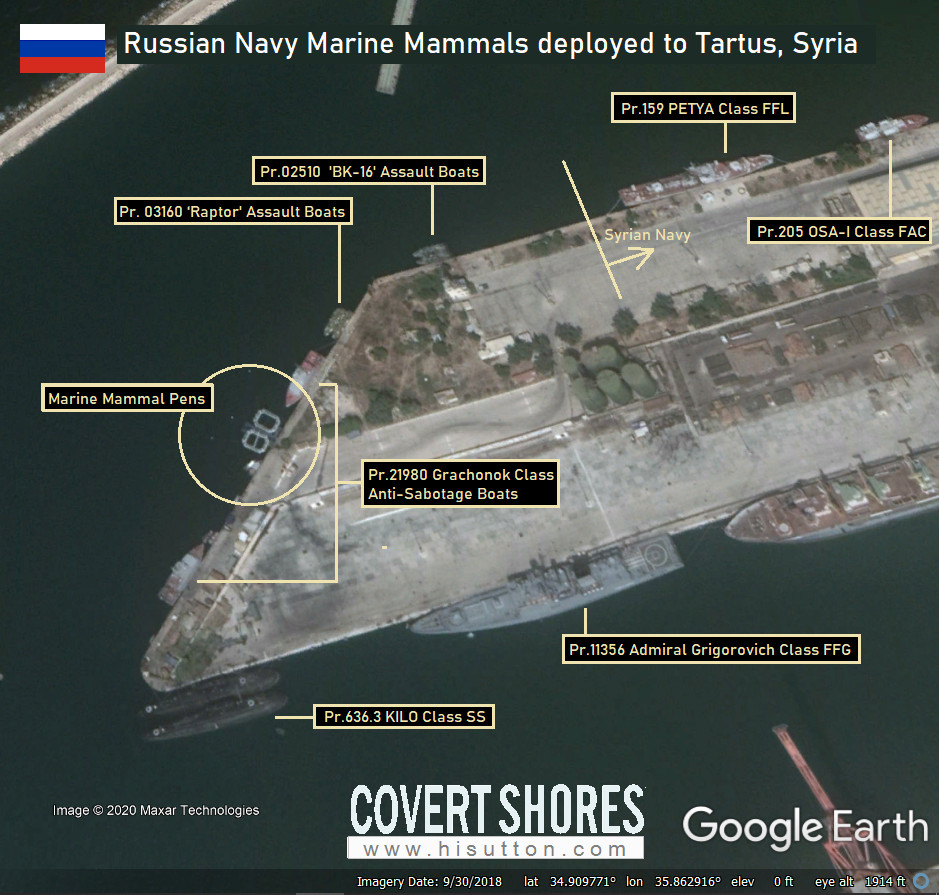
Israel
Israel is the most recent country to be associated with a marine mammal program. Hamas has accused them of operating dolphins against their frogman unit. They have shown a muzzle harness which is consistent with navy trained dolphins.
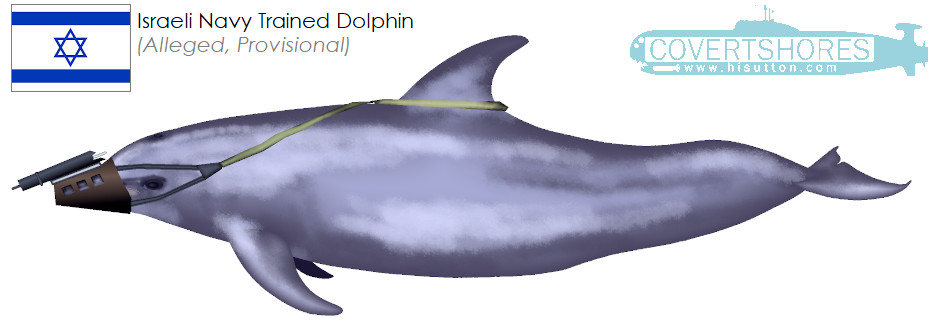
Although the Hamas reports should be viewed with caution, it is credible that the Israeli Navy has a dolphin program. These are likely based near key sites on the Israeli coast. They would perform counter-diver missions.
North Korea
There is strong circumstantial evidence, which I first revealed on USNI in November 2020, that North Korea has a dolphin program. The hermit kingdom is known to have trained dolphins for a water park in the capitol. However a new site has been established near Nampo on the West Coast of the country.
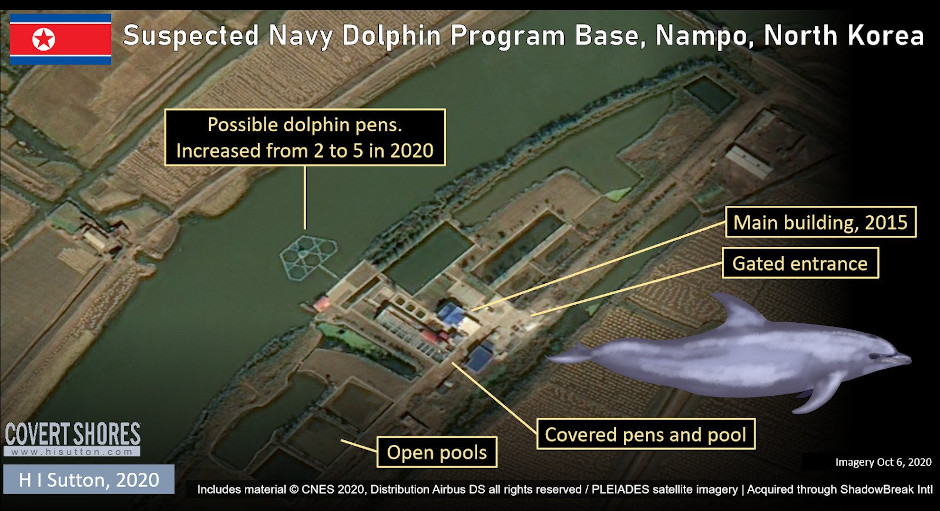
United States
The U.S. Navy has the oldest and most experienced marine mammal program. The NMMP (Navy Marine Mammal Program) was originally set up in the 1960s. Bottlenose Dolphins and California Sea Lions are trained for a range of missions. include counter-diver (force protection), mine clearance and retrieving test ordinance.
They are primarily based at San Diego but also have facilities on Hawaii.

NMMP sea lion trained for mine countermeasures, 2014. US Navy poto
Sweden (Historic)
In 1941 a unit was set up at Gålö in the Stockholm Archipelago to train seals. This was likely the first navy marine mammal program in the world. The scientist behind it, Valdemar Fellenius, trained the seals to locate mines, submarines, and torpedoes. See atlasobscura.com for more information.
Related articles (Full index of popular Covert Shores articles)

 Russian Navy Beluga whale
Russian Navy Beluga whale

 Low Visibility Craft Semi-Submersible dolphin delivery vehicle.
Low Visibility Craft Semi-Submersible dolphin delivery vehicle.
 Biomimetic Underwater Vehicles
Biomimetic Underwater Vehicles








 Covert Shores guide to underwater weapons
Covert Shores guide to underwater weapons



